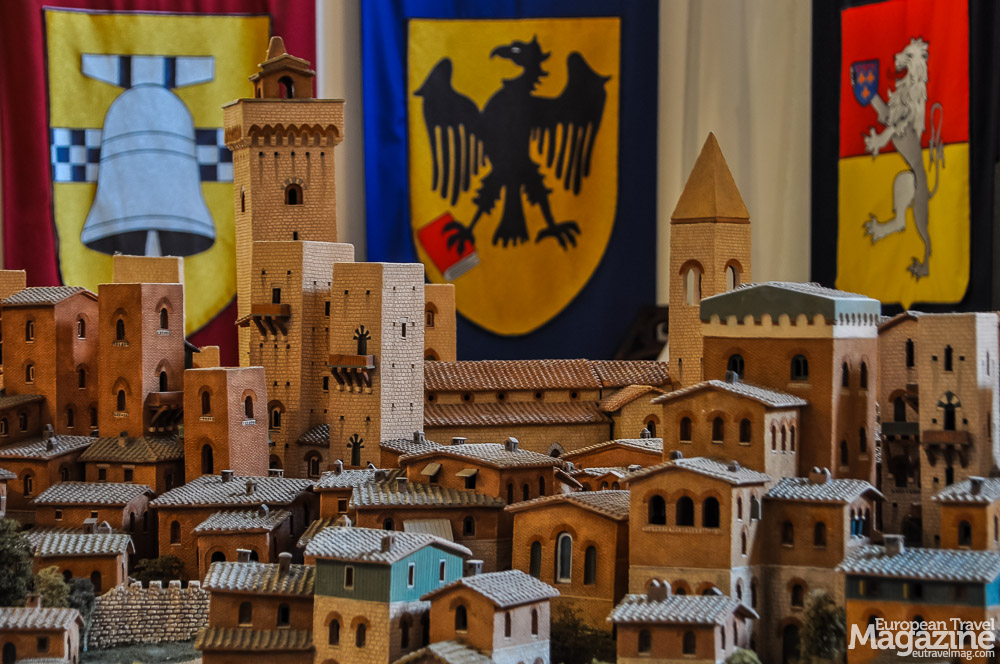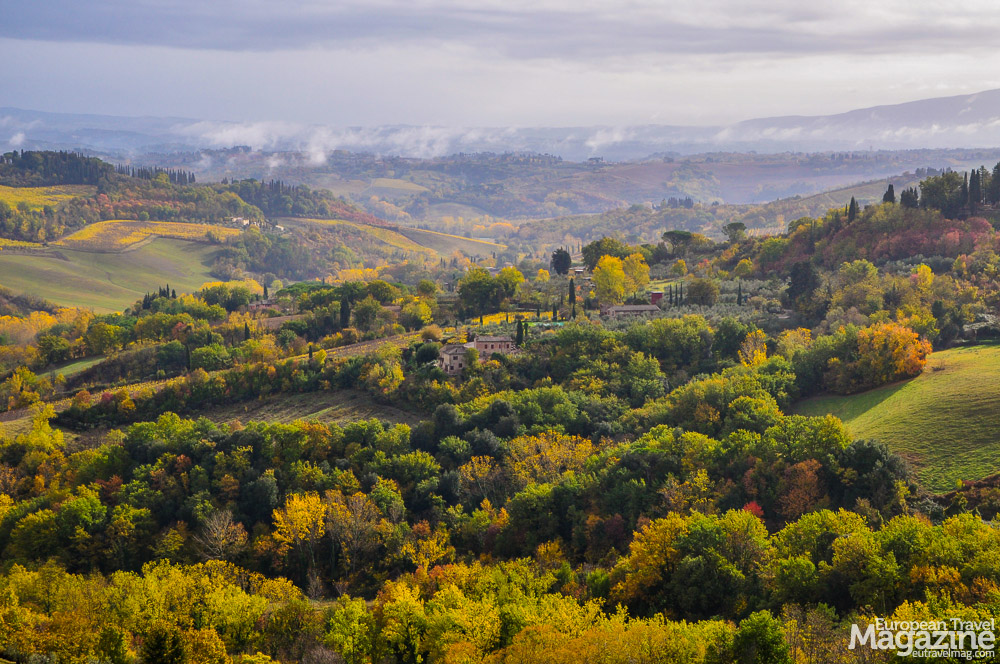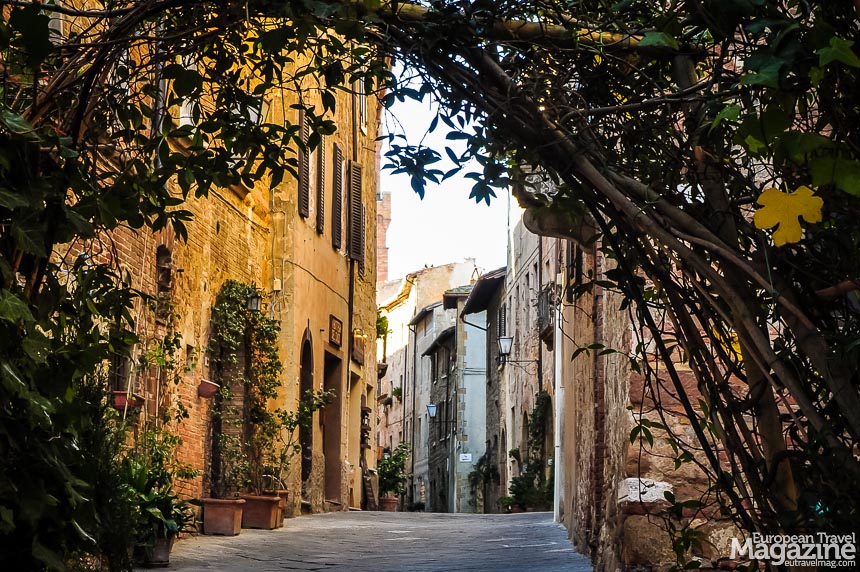Slender cypress trees, finely combed vineyards and fortified hilltowns, sitting enthroned on rolling hills, are the images that come to mind, when we picture Tuscany. Dating back to Medieval and even Etruscan times, these charming villages make history come alive with their rich heritage and generous architecture. Tuscany is an open-air museum, and hilltowns are the best places to get in touch with the historic ambiance of the region.
Boccaccio told tales about Certaldo in his Decameron and Dante described the imposing walls of Monteriggioni in his Divine Comedy. So poetic is the landscape and the hilltowns that conquer it, that it’s almost impossible to boil this list down to only 10. Here’s our effort:
San Gimignano
This Manhattan of the Middle Ages is an impressive sight to behold, when your car curves its way towards it through the Tuscan hillside. The pencil-shaped towers serve as lighthouses when hiking the landscape, guiding you safely back to this UNESCO World Heritage hilltown, where time has stood still. Although it is heavily trafficked by day-trippers arriving from Florence and Siena, it is most beautiful in the night time, where we love to sit in Piazza della Cisterna, surrounded by illuminated towers against a deep blue sky, listening to the swallows screaming.
Learn more about San Gimignano in our feature article about this towerful hilltown.
Volterra
Unjustifiably, Volterra has been standing in the shadow of UNESCO classed San Gimignano for many years, but this Etruscan enchantment is definitely worth a visit. It’s so quintessentially Tuscan, that is has been used as a backdrop for many movies and TV shows, such as Medici – Masters of Florence, where it acts as stand-for Florence.
The Palazzo dei Priori and the aptly named Piazza dei Priori, is the heart of this hilltop town. Its mind and spirit are the Etruscan museum, Pinacoteca and Civic museum, that offer insights to its unique Etruscan heritage and rich art legacy. Volterra’s stomach is the area south and east of Piazza dei Priori and offers restaurants, cafés and enotecas.
Certaldo
Located only 20 minutes north of San Gimignano, this final resting place of Italian poet and writer Boccaccio is also the setting for one of the stories in his Decameron.
“Certaldo, as you may possibly have heard, is a little town in the Val d’Elsa, in the hinterland of Florence. Although small, It was once the home of wealthy and noble people,” Boccaccio wrote.
While Certaldo may have grown out of its original, walled foundation and have spilled out into the valley, the fortified part on top of the hill is worth a climb and a visit. You can pay 1,5€ and take the funicular up the mountainside to save you the climb of 50 vertical metres. This charming village houses a Boccaccio museum, a town hall, a Sacred Art museum, a few churches and a couple of restaurants.
Even though it’s cute, small and a picture perfect hilltown, it has resisted the temptation of becoming a tourist circus and the small main road Via Boccaccia is pleasantly free from tourist shops. Here, it’s easy to find a good spot for an al fresco lunch, peruse the valley below and let the stories of Decameron come alive.
San Miniato
San Miniato is famed for its white truffle and a visit to this hilltown between Florence and Pisa is not complete without a truffle-themed lunch or dinner. Every year in November, the town comes alive for the international Truffle Market, where not only truffles, but all the splendid produce of Tuscany can be savoured. You can even go on a truffle hunt with locals. To learn how that turned out for us, follow us on our Hunt for the White Truffle of San Miniato.
The village itself sits enthroned atop three small hills overlooking the lower Arno valley. If you climb the cobblestone streets up to the La Rocca castle, you can enjoy the beautiful views all the way to the sea in the west and the mountains in the north. If you want an even better view, you can climb the ancient castle tower.
During summertime, the Tourist Office offers free guided tours on certain dates (booking necessary). On these events, and every Saturday and Sunday, you get to access the stunning rooms of the city hall and its colourful chapel of Madonna di Loreto. There is a lot to see and do – and eat! – in San Miniato, so even if you just stopped by on your way to or from Florence, you might just be wanting to stay.
- San Miniato Tourist Website
- San Miniato city guide brochure
- San Miniato on Discover Tuscany
- San Miniato on Wikipedia
Colle di Val d’Elsa
Gripping an oblong stretch of rock, Colle di Val d’Elsa balances above the waters of the Elsa river, to which it owes its name. As many other hilltowns, it spilled over its ancient walls and formed a new town below, but it’s the old part that is worth your attention.
You enter is after leaving the car in the parking area in the valley below. Walking along the main street of this town that’s shaped like a finger, you arrive at its heart at Piazza del Duomo, that’s dominated not only by the cathedral but the Palazzo dei Priori as well. Continue your walk to the end of the old town at the panoramic balcony of Il Baluardo, that offers beautiful views to the new town below and the countryside.
- Colle di Val d’Elsa Tourist Website (in Italian)
- Colle di Val d’Elsa on Visit Tuscany
- Colle di Val d’Elsa on Discover Tuscany
Monteriggioni
On the road between Florence and Siena, you will come upon this fortified hilltown inspecting you as you approach, like it has done for no less than 800 years. This borgo was Siena’s northern line of defense against rival Florence, and the fourteen towers you still see today, were used in the Middle Ages to control the area, overlooking the Cassia road between the two enemy city states.
It has perfectly preserved its structure, that is characterized by ten-meter-high fortified walls, built along the natural contour of the hill. You can walk along a little stretch of the ancient wall for 3€ and imagine how soldiers did so for hundreds of years back in the Middle Ages and the Renaissance. When Siena was ceded to Florence in 1555, it lost is military importance and so, little used, remained in perfect condition for the tourists of today, that come visiting this real life Medieval castle town.
Montepulciano
Famed for its Rosso di Montepulciano, this small, wine producing town is also quite a moviestar, albeit for a younger audience, as Montepulciano was used as stand-in for Volterra in the teenage vampire movie “Twilight”.
It’s quite a steep climb up the cobblestone streets to the centre of the town at the typically Tuscan town hall Palazzo Comunale, designed in the tradition of Palazzo Vecchio in Florence. But worth every step.
On your struggle to reach the very top of the hilltown from the parking lots at the outside of the city walls, you encounter wine shops, underground cellars dating back to medieval times, and artisan boutiques. Plenty of reasons to catch your breath and explore the history. Wait for your return to reduce the weight of your wallet and stock some local delicacies and full-bodied reds.
On our Wine Tour through Tuscany, we took a closer look at Montepulciano, so that’s worth a read if you want to know more about the hilltown and its wines.
- Montepulciano Official Tourism website
- The Wines of Montepulciano Official website
- Montepulciano on Visit Tuscany
Pienza
When driving from Montepulciano to Montalcino, you encounter the honey-coloured hilltop town of Pienza. You’re in the southern part of the legendary and UNESCO World Cultural classed landscape of Val d’Orcia, where vineyards have given way to golden fields of crops.
This soft, waving land was the birthplace of later Pope Pius II, that bejewelled his birth town. During his papacy, he changed the medieval Castello di Corsignano into a Papal residence in the Renaissance style. Indeed, the entire village was rebuilt as an ideal Renaissance town and renamed after himself to Pienza.
The town sits self-assured on top of a large hill and is easily accessible after you parked your car just outside the city walls. It’s a comfortable stroll through the very orderly, bright town, that offers spectacular views of the countryside. No wonder this perfect miniature Renaissance village was named a UNESCO World Heritage back in 1996.
Montalcino
Brunello di Montalcino: The wine, that made this small town famous and swarmed with tourists in the summertime. No wonder they make some of the world’s best wine: they’ve been producing and refining Montalcino wines since the 15th century.
Visit the city’s largest tourist attraction, La Fortezza, a fortress from the 14th century, for tasting and purchasing the famous drops. At the Enoteca, you can enjoy a light lunch while tasting 2, 3, 5.. different Brunellos, Rossos or other SuperTuscans. Or you can just buy the wine by the glass to indulge in your very favourite. To know more about the wine and Montalcino, check out our article about Montalcino in Wine Touring Tuscany.
A visit to Montalcino is a rapid rendezvous, as this small hilltop town of only 5.000 citizens is quickly conquered. To prolong your stay in this charming wine country, take your car for a 15-minute spin down south to the Abbey of Sant’Antimo. This Carolingian monastery can date its roots back to the time of Charlemagne, and is beautifully set in a valley surrounded by hills and olive trees.
- Montalcino Official Tourism website
- Enoteca la Fortezza di Montalcino
- Brunello di Montalcino on Wikipedia
Cortona
This eastern-most of our Tuscan hilltown ensemble, Cortona is known for two things: Being the setting for Frances Mayes’ memoir “Under the Tuscan Sun” and the important museum of Etruscan history and culture; MAEC. Alright, perhaps it’s best known from “Under the Tuscan Sun” but the museum of MAEC is really worth a visit, if not for its wonderful library, which we featured in The Most Beautiful Libraries of Tuscany.
The small village is tucked away behind ancient walls, and you must park your car outside to venture into its steep streets, that climb 50 vertical metres to the centre, where the Town Hall crowns Cortona. Behind the Town Hall, Palazzo Casali features MAEC as well as the public library. It was occupied by the city’s Florentine captains back in early Renaissance and the coats of arms of these captains are still visible on the right hand façade of the building, on Via Casali, which has remained virtually unaltered.
Despite its small size, Cortona has a lot to offer and the small square in front of the Town Hall just beckons to sit down with an espresso and take in Tuscan everyday life, Preferably under the Tuscan sun.
Learn more
- Tuscany’s official Tourism website
- Discover Tuscany website
- Tuscany of Italy´s official Tourism website
- WeTuscany Rental Agency (comes highly recommended by us!)































































































